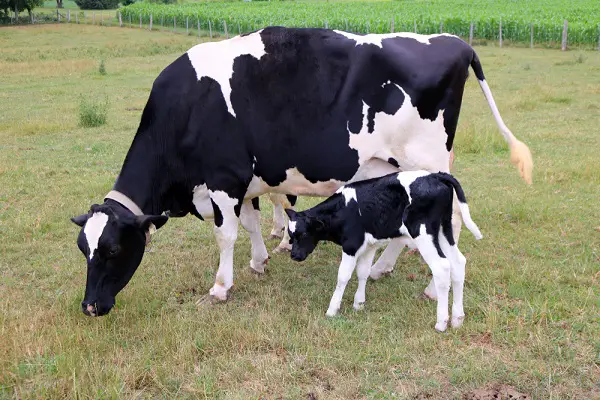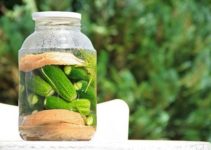Cattle are viviparous animals and have a gestational period of nine months on average. In this article, everything about the cattle gestation, when they reach sexual maturity, the characteristics of their reproductive cycle and the calving process are discussed.
Cow Estrous Cycle
The estrous cycle of cows, as in all species, begins at puberty; the age of puberty (first estrus) is between 8 and 18 months. The first ovulation is in silent heat (there is no psychic manifestation of heat). Once puberty is reached, cows can come into heat all year because they are polyestrous. The cow estrous cycle lasts for 21 days on average, with a difference of 1 to 3 days. The estrous cycle in cows can only be interrupted by gestation, during 3 to 6 weeks postpartum (postpartum anestrus), during high milk production, nutritional deficiencies and pathological conditions.
The estrous cycle of cattle is divided into four phases that are characterized by having very specific hormonal conditions. These phases are Proestrus, Estrus, Metestrus and Diestrus.
- Proestrus: it is the phase that precedes heat. It is characterized by a marked increase in the activity of the reproductive system. There are a follicular increase and regression of the corpus luteum from the previous cycle. The uterus increases in size, the endometrium is congested, edematous, and its glands have abundant secretory activity. The vagin.al mucosa is hyperemic, the number of cell layers that make up its epithelium increases, the upper ones being cornified. Its duration is 3 to 4 days.
- Estrus: it is the period of sexual receptivity or acceptance to the male. The beginning and end of the estrus are perfectly detectable moments in the estrous cycle; therefore, they are usable as a reference point to determine its duration. The female generally searches for the male and remains still in his presence for cover. There are nervousness and excitement, frequent bellowing, decreased appetite and milk production, and dilated pupils. The glands of the uterus, cervix and vagin.a secrete an abundant quantity of mucus-like egg white. The vul.va and vagin.a are congested. The cervix is dilated. At the level of the ovaries, during proestrus and estrus there is follicular growth with the absence of the functional corpus luteum, with estrogens being the hormones responsible for the behavioral change in the cow. Proestrus and estrus are known together as the follicular phase of the estrous cycle. Cows in heat or in the period around it tend to congregate in groups that mount or attempt to mount each other: sexually active groups (GSA). The cow in heat is the one that remains still when mounted. This period is very short, approximately 8 to 18 hours long. Additionally, cows in heat usually ride one another. The female that remains still is the one that is in heat. The female who rides may or may not be in heat.
- Metestrus: it is the phase immediately after estrus. Ovulation in the cow is a spontaneous phenomenon that takes place about 12 hours after the end of the estrus. The granular cells of the follicle that has ovulated are transformed into luteal cells, from which the corpus luteum is formed. In this phase, the secretions of the uterine, cervical and vagin.al glands are reduced. The heat symptoms begin to disappear. In some animals, bloody mucus can be seen exiting the vul.va and sometimes sticking to the tail hairs, which is normal. The duration of this stage is from 2 to 4 days.
- Diestrus: This is the period in which the corpus luteum is functional, forming large amounts of progesterone. Hyperplasia hypertrophy of the uterine glands disappears and the cervix contracts. The secretions of the genital apparatus are little and sticky. The vagin.al mucosa becomes pale. The period of the estrous cycle in which the corpus luteum is functional is called the luteal phase of the cycle. Taking into account that estrus is the only externally identifiable phase of the estrous cycle, in polyestrous species, the cycle is divided into estrus and interestrus, the latter including the phases of proestrus, metestrus, and diestrus. The diestrus is the longest stage of the cycle (about 14 days) and is the only phase that can be manipulated, which in reality consists of using drugs to shorten or prolong this stage, so that once the same is suspended the animals go into heat more or less at the same time. During days 16 to 18 of the cycle, if the uterus has not detected the presence of an embryo, it sends a hormonal signal (prostaglandins) that causes the corpus luteum to regress and the cycle restarts. In pregnancy, the uterus and the embryo produce hormones (collectively they are called EPF: early pregnant factors) that help maintain the pregnancy.
Cow Gestation Period
How Long is a Cow Pregnant?
The gestation period in cows is 279 – 287 days from the first day of mating. Cows have an average gestation period of 283 days. As with other animals, this gestation period varies consequently with the breed, size and age of the pregnant cow. These could also influence the size of the fetus that is being carried. Premature births are usually rare in cattle.
☛ Check This Out: Cattle Gestation Calculator and Chart
Cow Pregnancy
Signs of Pregnancy in Cows
Unlike most mammals, it is somehow hard or impossible to know if a cow is pregnant by using outward physical signs or symptoms. For this reason, a few medical tests can be carried out to diagnose bovine pregnancy.

An experienced ranchman or veterinarian can use techniques such as detection of estrus signs, ultrasonography, measurement of plasma or milk progesterone levels and rectal palpation to detect if a cow is pregnant.
- Detection of Estrus: Cows usually come into heat every 21 days. That is, a cow is expected to show signs of heat every 21 days. If a cow mates with a bull and does not come into heat (or does not show the signs of heat) after another 21 days, it’s possible that the cow is pregnant. On the other hand, if the cow enters back into estrus 21 days after the last estrus cycle, it means the scow is not pregnant. Some signs of heat in cows include mucous discharge from the vagin.a, chalking of the tail, standing to be mounted, mounting other cows, swelling of the vul.va and frequent urination.
- Ultrasound Check or Ultrasonography: Ultrasonography is done using ultrasound machines. It involves inserting and positioning an ultrasound probe above the uterus through the rectu.m. Pulses of ultrasound are generated, thereby producing an electrical signal. The electrical signal produced is further processed with a scan converter and shown on a monitor. If the cow is pregnant, the embryo of a growing calf should be seen on the monitor.
- Plasma or Milk Progesterone Levels: The concentration of progesterone hormone in the milk or plasma of a cow can be used to determine if such a cow is pregnant. Milk or blood samples are collected and tested for progesterone concentration. If the progesterone concentration in the sample is high, then the cow is possibly pregnant.
- Rectal Palpation: Rectal palpation on cows is done using the hand. This method involves feeling the uterine asymmetry or slippage of the fetal membrane along a cow’s uterus. While the palpation of the fetus might be impossible when the fetus grows too big, it is possible to feel parts of it.
- Late Pregnancy Indicators: The abdomen of the cow will enlarge when the fetus grows bigger. At this stage, it might be possible to detect the fetus’s heartbeat with an ultrasound machine.
Cow Calving
Calving is a process of giving birth to a calf by a cow. After nine months of pregnancy, the calf is ready to be expelled, so the birth occurs naturally and the calf is born. At this point, it is convenient to have a good bed prepared on a sand or gravel floor, in a covered place that is well ventilated and clean.
Signs of Labor in Cows
The signs of labor in cows are:
- Restlessness. The cow sits down and gets up often
- Tail flicking. The cow flicks her tail frequently
- The cow’s udder gets bigger and fills with milk. The teats on the udder become firm, smooth and bigger
- Separation from the herd
- Refusal to eat
- The vul.va gets swollen and streams of mucus discharge
- The feet and nose of the calf appear at the vul.va
Stages of Labor in Cows
The calving process of cows is in three (3) stages, and they are triggered by neuronal and hormonal signals from the body. The first phase has a maximum duration of 24 hours and is when the uterine dynamics and dilation of the female’s cervix begins. Once the conditions for birth are created, the calf makes its way through and passes through the vagin.al canal. Experienced cows don’t usually need help in this phase, but some inexperienced cows do. The third and final phase consists of the expulsion of the placenta, which is useless for a mother once the calf is born. If after 12 hours after the birth the cow has not managed to expel all the fetal membranes, it will be necessary to call a veterinary specialist to help in removing the placenta.
Number of Calves
The reproduction of cattle is of utmost importance to our society. These domestic animals play a fundamental role in human nutrition, so that is why man always tries to obtain the largest number of offspring from each animal. The amount of calves that a cow can provide depends on various factors such as the nutritional status and genetics of the individual. However, a healthy specimen with proper reproductive management should produce one calf per year.


